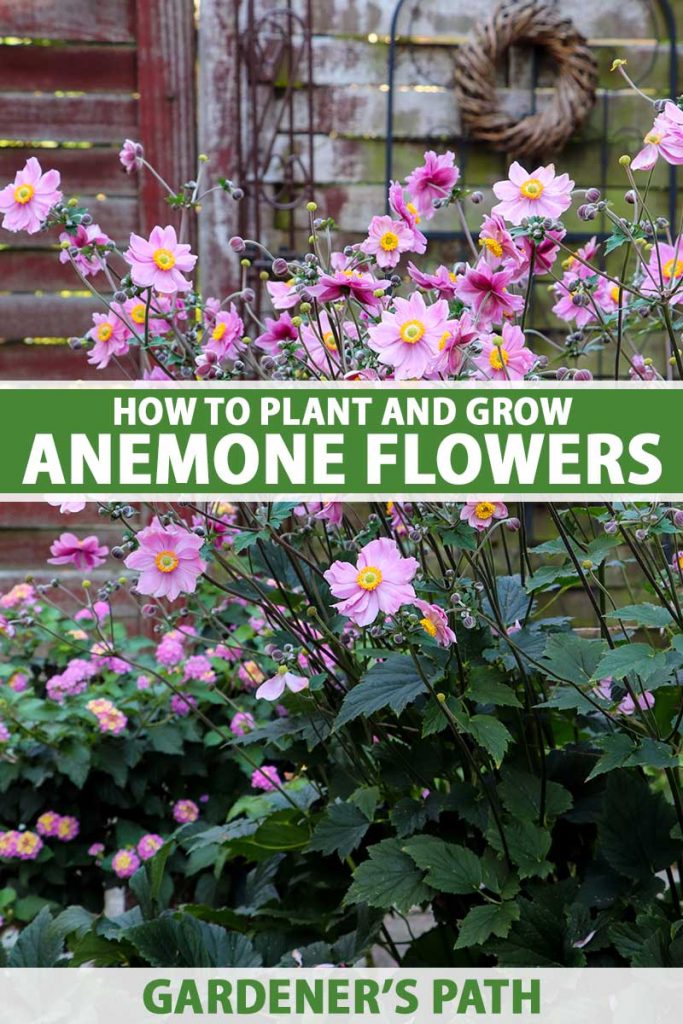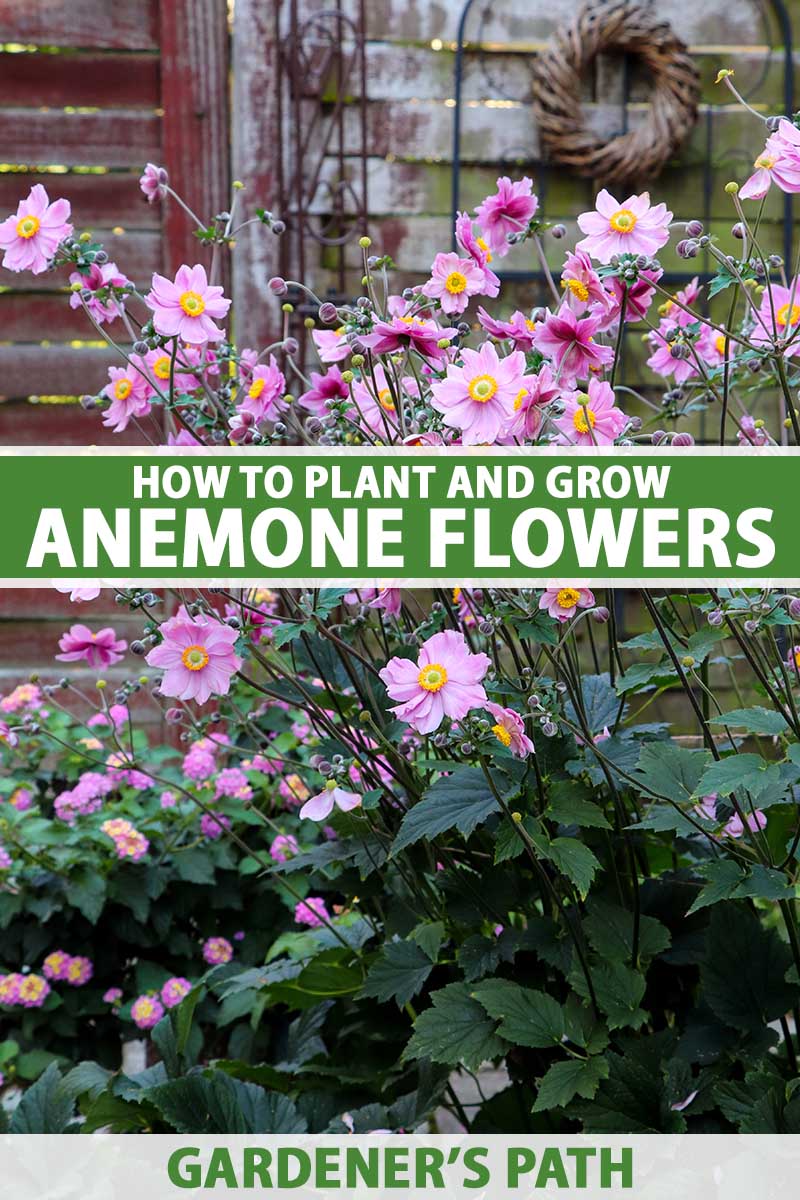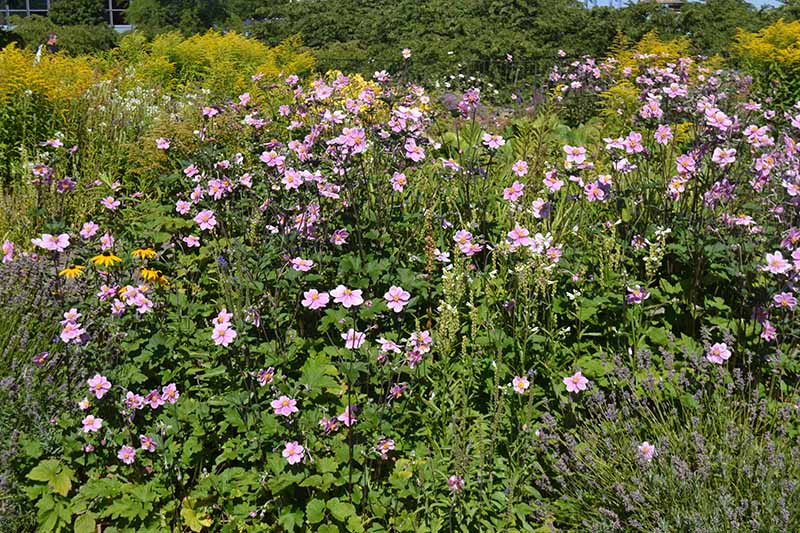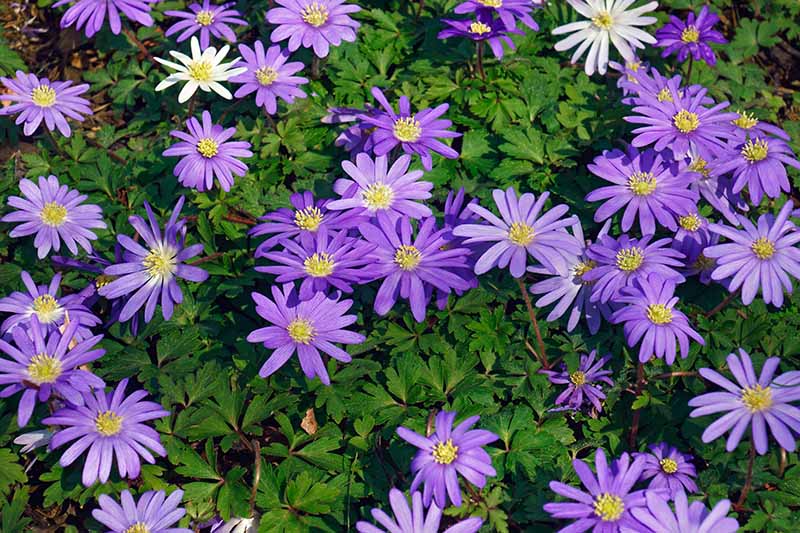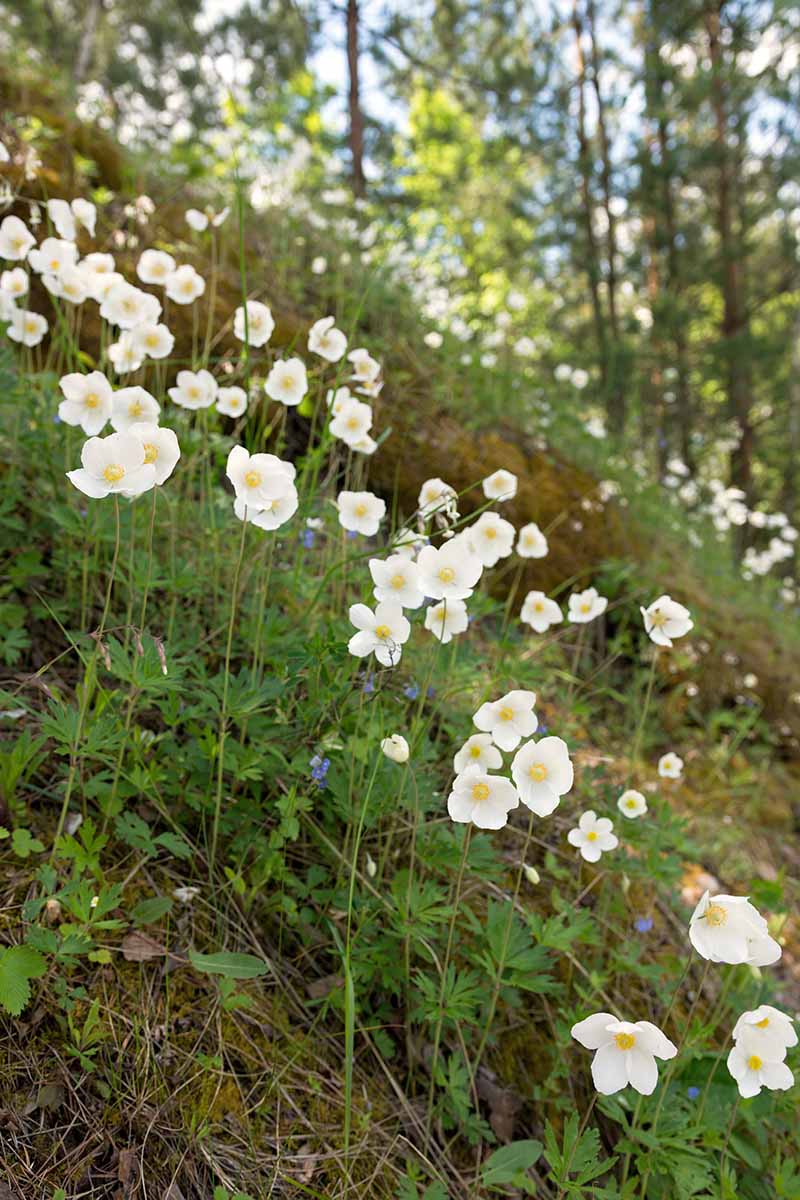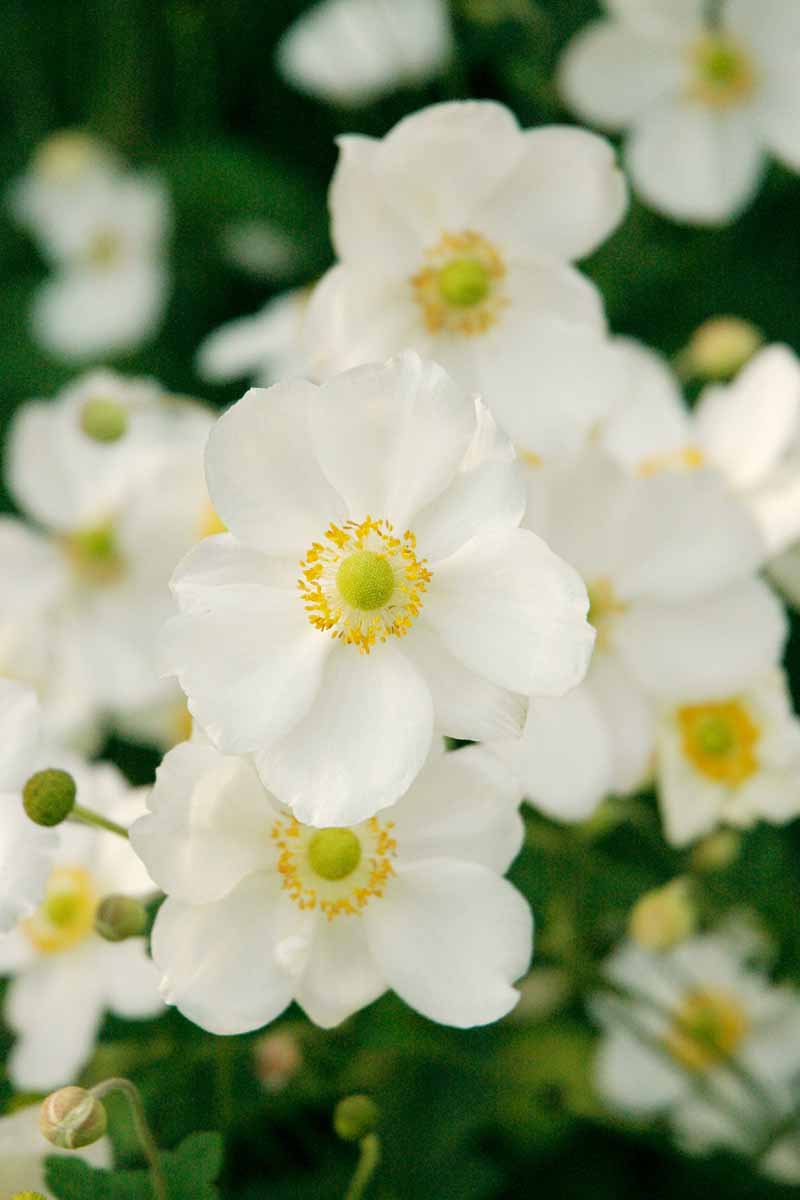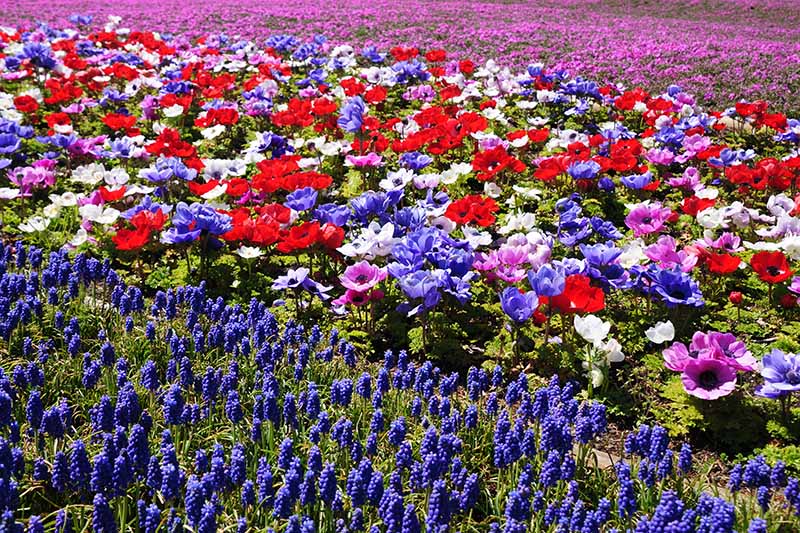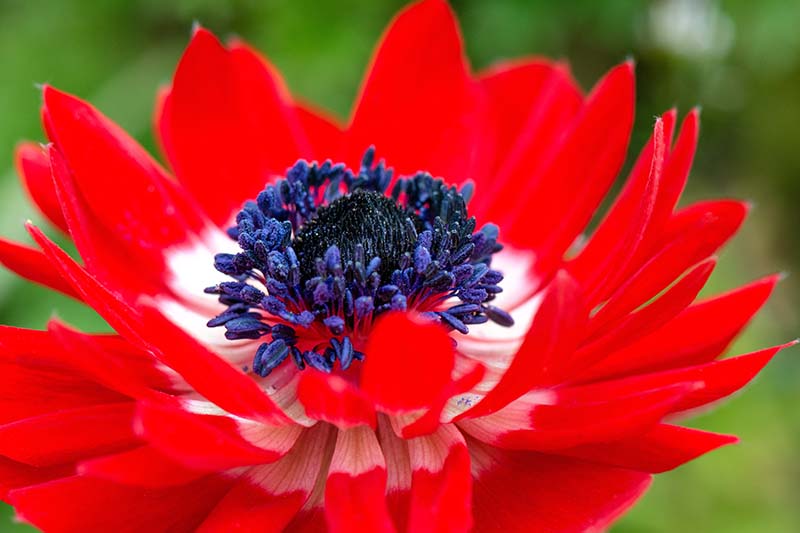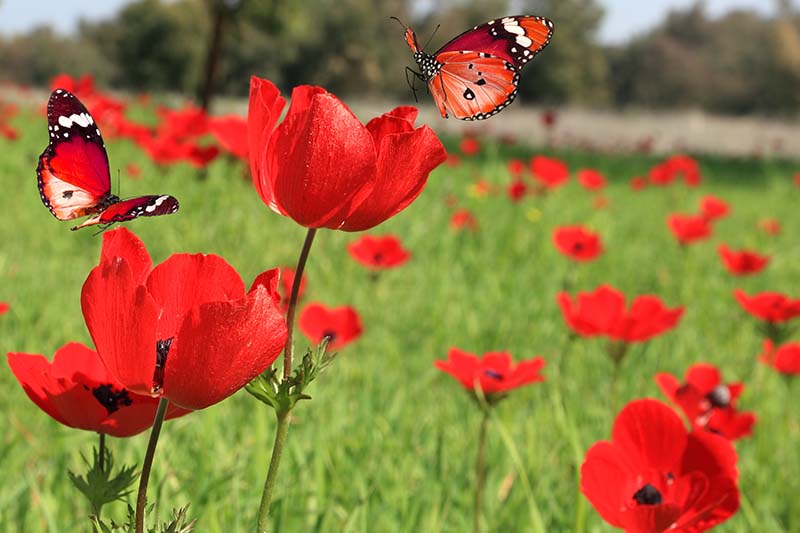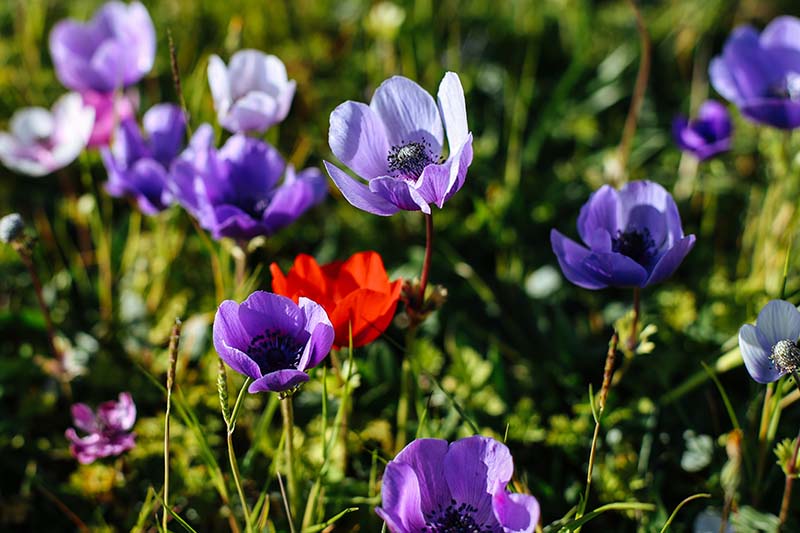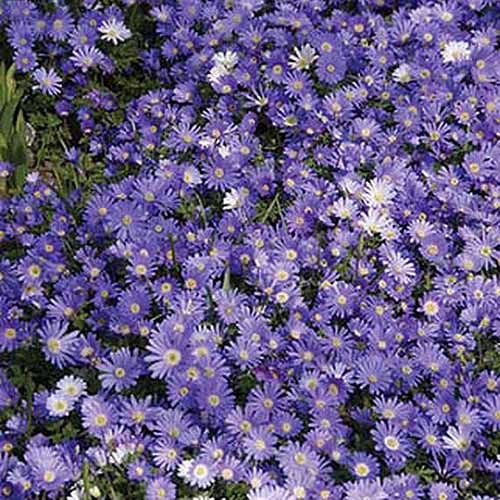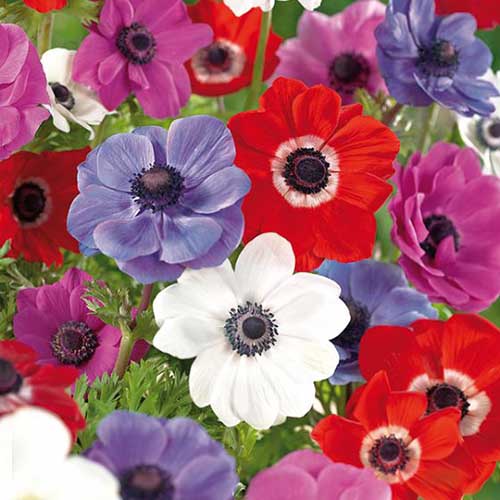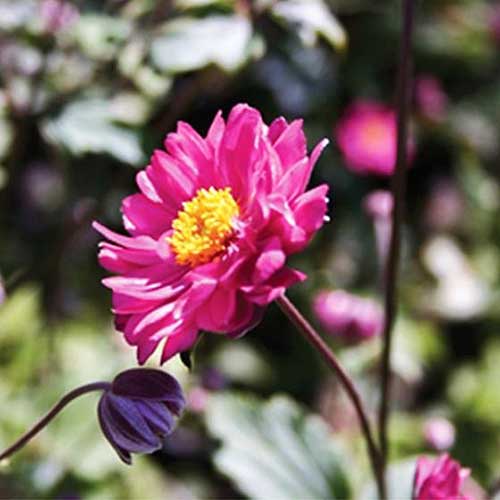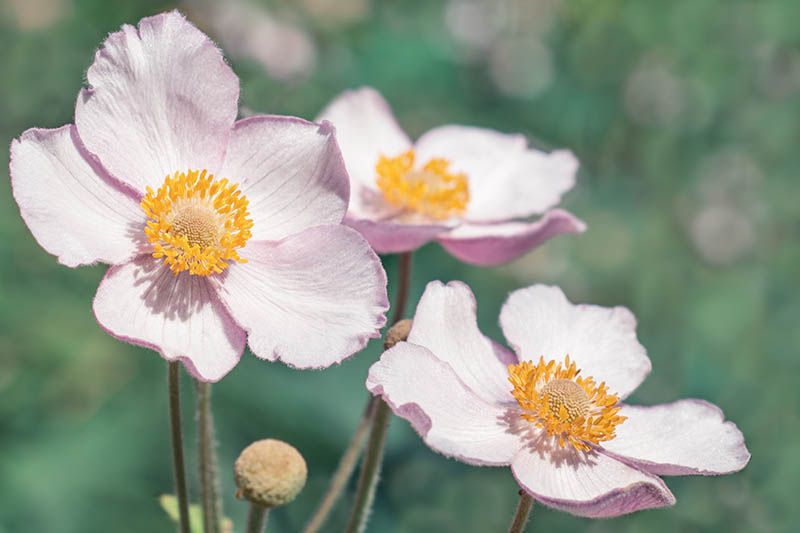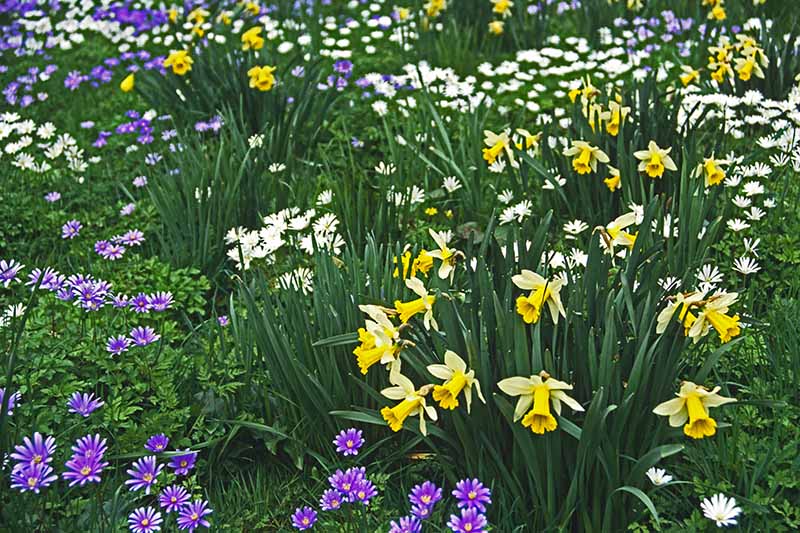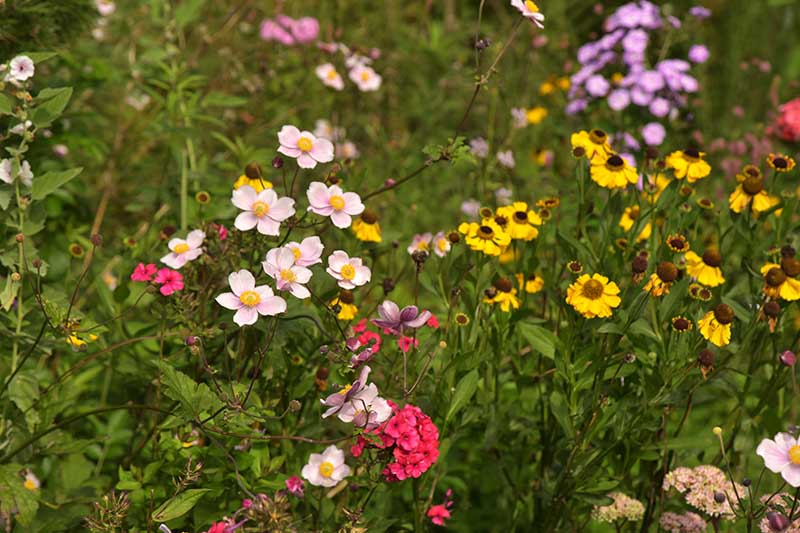Commonly called windflowers – their slender, sturdy stems tremble in a breeze but don’t break – the eye-catching flowers bloom in early spring, summer, and fall, depending on the variety. The spring and summer species bloom in vivid shades of bluey-mauve, pink, purple, red, scarlet, and white while the fall bloomers are more restrained in hues of mauve, pink, and white. We link to vendors to help you find relevant products. If you buy from one of our links, we may earn a commission. They form large mats of color that make a stunning addition to containers, beds and borders throughout the garden, rockeries, or naturalized in meadows and wild gardens. Most are tolerant of partial sun conditions, making them ideal for light shade gardens and open woodlands as well as sunny spots. Plus, many are also exceptional as cut flowers! Species with tall, elegant stems produce flowers that are long lasting in a vase with good color retention. Sound like something your garden needs? Then read on to learn all about how to plant and grow anemone flowers. Here’s what I’ll cover:
What Are Anemones?
Anemone is a diverse genus in the Ranunculaceae (buttercup) family, with over 120 species of flowering plants.
These herbaceous perennials are native to temperate, subarctic, and subtropical regions of Africa, Asia, Europe, and North America. Their habitat ranges from high, subalpine meadows to hot Mediterranean hillsides to temperate riverbanks and open woodlands. Wonderfully low maintenance, they have attractive flowers that bloom for three to six weeks. All species are attractive to pollinators like bees and butterflies, but resistant to deer, rabbits, and rodents. For gardening purposes there are three main groups to consider:
Spring Flowering
The first group is the spring flowering species that grow from tubers (corms) or rhizomes. Typically, these are species plants with few hybrids. A. blanda, also known as Grecian windflowers or Balkan anemones, is the mainstay of the spring flowering group.
Low growing with mature heights of four to eight inches, multiple stems of charming daisy-like flowers grow from ferny foliage and bloom in late winter to early spring for four to six weeks. A welcome sight in the early garden, flowers have green-gold, button eyes and long, slender petals. Flowers appear in bright splashes of azure blue, magenta pink, mauve, and white that close at night or when rain threatens. Corms are sown in fall and can be planted on their own or as an attractive companion for other early bloomers such as daffodils, grape hyacinth, snowdrops, and tulips. They’re hardy in USDA Hardiness Zones 4-9 and enjoy a full to part sun location. Other spring bloomers include the alpine and woodland species, including A. canadensis, A. virginiana, and A. sylvestris. These have single flowers that are star- or cup-shaped with wide petals (tepals) in cream or white, with some mauve and pink flowering species such as A. nemorosa and A. tuberosa. Yellow flowers are uncommon, and are only seen in a few species, such as A. ranunculoides and A. richardsonii. These native species can spread vigorously and are best suited for planting where they can colonize without interference. Also, they can be hard to source at large garden centers but are often found at shops that specialize in native, rare, or wild species. Typically, plants are hardy in Zones 3-8 and the wild species also enjoy full to part sun exposure.
Summer Flowering
Summer flowers come from the popular A. coronaria species, aka poppy anemones, which also grow from corms. These are almost always hybrids, with the ‘De Caen’ and ‘St. Brigid’ series among the most popular. And thanks to their early summer bloom time, these are the windflowers most often found in bridal bouquets. Mid-size plants grow eight to 16 inches tall, with multiple stems of bright, poppy-like flowers in vivid colors of sky blue, magenta, mauve, scarlet, and pink with dramatic, dark eyes and fine, parsley-like foliage. As they are heat lovers from the Mediterranean, these types like a full sun location. A tuberous-rooted plant, the corms can be sown in fall or spring. Hardy only in Zones 7-10, when planted in the fall as a perennial they bloom in late spring into early summer for four to six weeks. In colder regions, the corms can be lifted for winter storage or they can be grown as annuals, blooming three months later in early to midsummer.
Fall Flowering
Fall flowers come from A. hupehensis and a number of hybrids called A. x hybrida, collectively known as Chinese or Japanese anemones. These plants have hard rhizomes, or fibrous roots that are planted in fall or spring.
The Japanese types are tall, growing to mature heights of 24 to 48 inches. They feature branched stems and large, saucer-shaped flowers in mauve, a wide range of pinks, and white – all with large button eyes of chartreuse or gold. Plants spread by underground runners and form long-lasting mats as they spread. They can become invasive given ideal conditions, like in Hawaii. For the rest of us, the spread is slow and easy to control. They prefer full sun with afternoon shade, or a dappled shade location. Superb as a cut flower, they also attract late-season pollinators. A. hupehensis is hardy in Zones 4-8. Other fall-flowering species include A. tomentosa and A. vitifolia.
Cultivation and History
The word “anemone” is derived from the Greek word for wind, anemos, due to the play of wind in their petals and their swaying dance in a breeze.
They have a long history of cultivation and are mentioned in the first century AD in Pliny the Elder’s renowned tome, Natural History.
The Renaissance period heralded a new interest in botanical studies, with windflowers a highly studied specimen. In mid-15th century Europe, botanists collected and dried wild specimens of A. blanda and A. coronaria, then successfully introduced them into gardens. But for such a bright, uplifting flower it has some dark associations! Greek mythology tells us the anemone sprung up from the mixing of Aphrodite’s tears with the blood of her dead, mortal lover, Adonis – the flowers came to symbolize the death of a loved one or forbidden love. In the Middle Ages, flowers were worn on the collar by European peasants to protect against pestilence and plague. From this practice, it became associated with illness and was thought to bring bad luck. And Chinese culture tagged the red windflower as the flower of death.
A cheerier slant comes from British folklore, which tells us magical fairies sleep in the flowers – snugly tucked in, as the petals close over them and flower heads nod for the night!
Propagation
Propagation from seed is possible in the case of species plants, such as A. blanda, but germination may be unreliable and it takes two years for seedlings to flower. Seeds collected from cultivated varieties, like cultivars of A. coronaria and A. hupehensis, don’t grow true to the parent plants.
But all species are easily propagated from plant division or root cuttings taken in spring or fall. The easiest way to get started is to purchase bulbs or bare root plants from a garden center or nursery for planting in fall. We’ll provide some recommendations in the cultivars section below. Space the smaller species, A. blanda and A. coronaria, two to three inches apart, and the taller types 12 to 14 inches apart.
How to Grow
All species enjoy the same growing conditions of humus-rich, evenly moist, well-draining soil that has a pH in the range of 6 to 7.5. Spring flowering varieties prefer a part to full sun location, the summer species like full sun, and fall bloomers enjoy full sun with afternoon shade or light shade.
Fall is the best time to plant all varieties for perennial growth, but A. coronaria can be planted in spring as an annual in regions where it’s not winter hardy. Keep in mind that the foliage of A. blanda dies back in summer, which can make it difficult to remember their exact location. Mark their spot with a small stake before mounds die back to prevent accidentally digging up the roots. Taller species are best planted in a location that is protected from strong winds, such as beside a fence or shed. All species thrive in soil that’s kept evenly moist, but they can’t tolerate wet feet, which can lead to root rot. Detailed instructions for propagation and planting A. blanda and A. coronaria can be found in our guide to growing Grecian windflowers. Our guide to growing Japanese anemone flowers has details on how to propagate and grow fibrous rooted types.
Growing Tips
Keep the following tips in mind for cultivating strong, healthy windflowers:
All species require evenly moist soil, but good drainage is crucial to prevent root rot. Amend your planting site with landscape sand or pea gravel if needed. Plants enjoy a full to part sun location but do best with afternoon shade in areas with intense sunshine. A winter mulch of straw or leaves protects roots from freeze and thaw cycles and drying winds. The tall stems of A. hupehensis also appreciates some protection from strong winds.
Pruning and Maintenance
Maintenance and after-flowering care are simple for all species. Grecian windflowers go dormant in early summer, which is when the foliage dies back. Rake the dead foliage to clean up the area and reduce watering.
Poppy anemones require regular watering until the foliage dies back in fall, when stems can be cut to the ground. If you live outside of their hardiness zones, corms can be dug up in fall, dried, and packed into dry peat moss or vermiculite for winter storage. Store in a dark, dry, well-ventilated area and plant out in spring. Japanese windflowers can be cut back in late fall after the foliage turns brown and dies back. All species appreciate a winter mulch of bark, leaves, or straw to protect the roots from cold temperatures, freeze and thaw cycles, and drying winds. In spring, apply a top dressing of organic matter such as compost, leafmold, or aged manure – or feed with a balanced fertilizer, such as 10-10-10 (NPK) according to package instructions.
Managing Pests and Disease
Anemones are carefree plants with few problems, although there are a few issues to watch for. For more ideas, be sure to read our roundup of 15 of the best anemone varieties.
Blue Shades
Flowering brightly amid ferny foliage in early spring, A. blanda ‘Blue Shades’ have bright, white eyes set in flowers that range in shades of blue from light powder to periwinkle. These are low-growing plants with a height of only four to six inches and look terrific when planted in drifts or with other early bloomers.
‘Blue Shades’ Corms are sown in fall and can be placed at the front of borders, as an underplanting in perennial beds, in containers, rockeries, or scattered under deciduous trees. They are fantastic when allowed to naturalize in wildflower meadows or open woodlands. Hardy in Zones 4-8. You can find packets of 15 bulbs available at Burpee.
De Caen Mix
Blooming for three to six weeks from mid to late spring, the ‘De Caen’ Mix (A. coronaria) produces large, buttercup flowers in vivid shades of magenta pink, scarlet, violet, and white with fine, ferny foliage. Hardy in Zones 7 to 10, plants reach heights of eight to 10 inches and quickly form mounding carpets when grown in full sun. Provide afternoon shade in hot regions.
‘De Caen’ Mix Delightful as a groundcover, they also look spectacular when mass planted in beds, borders, and containers, or planted in alpine, cottage, and rock gardens. You can find packets of 12 bulbs available at Nature Hills Nursery.
Honorine Jobert
Highly popular, ‘Honorine Jobert’ (A. x hybrida) adds an elegant presence to the late summer and fall garden with gorgeous white flowers and pretty, gold stamen. ‘Honorine Jobert’ received the Award of Garden Merit from the Royal Horticultural Society in 1993.
‘Honorine Jobert’ Tall and stately, the three- to four-feet plants add flair to cottage and cutting gardens, shrubscapes, woodland settings, or mass planted in beds, borders, and containers. Plants love a full to part sun location and thrive in humus-rich, moist soil. Hardy in Zones 4-8. You can find bare root plants available at Burpee.
Mona Lisa
Highly prolific, A. coronaria ‘Mona Lisa’ puts on a dazzling display in late spring to early summer and features large, poppy-like flowers in orchid pink with dazzling, dark eyes. Flowers sit atop long stems amid mounding, parsley-like foliage.
‘Mona Lisa’ Gorgeous as long-lasting cut flowers, and they make an eye-catching attraction for bouquets or in beds, borders, containers, and alpine or rock gardens. And they can re-bloom lightly in fall. Plants reach a height of 18 inches and enjoy full or part sun location with afternoon shade. Hardy in Zones 5-8. You can find sets of four plants available at Burpee.
Pamina
Big and showy double blooms of deep, hot pink with a frothy gold eye make A. hupehensis var. japonica ‘Pamina’ a star attraction in the fall garden. A beautiful plant to extend the growing season, they’re ideal for cottage, cutting, and shade gardens, naturalized settings, or mixed into shrubscapes, beds, borders, and containers.
‘Pamina’ Carefree and low maintenance, plants are hardy in Zones 5-8, grow two to three feet tall and enjoy a full to part sun location. Plants are available at Nature Hills Nursery.
Caterpillars, slugs, and snails enjoy noshing on the flowers, foliage, and stems of all varieties. Handpick and dispose of these pests when you see them. And if gastropods are a regular pest for your flowers and veggies, read up on how to protect your garden from slugs and snails right here. Bacterial or fungal infections like leaf spot or powdery mildew can also make appearances. For leaf spot, watch for dusty or sooty spots that gradually turn yellow, then brown. Remove and dispose of all infected leaves. Do not place them on your compost pile. Powdery mildew appears as a pale fuzz on the leaves and can be caused by poor air circulation or damp, cool conditions. Remove any infected material and dispose of it. Improve circulation by thinning plants or locate in full sun as a preventive measure. Learn more about powdery mildew in this guide. Root rot occasionally appears and it is typically caused by poor drainage. To ensure roots don’t stand in water over winter, amend with landscape sand or pea gravel as needed.
Best Uses
Windflowers are adaptable and multitalented, lending their charm and color to a variety of garden settings. All put on a dazzling display when planted in large drifts in beds, borders, containers, or rockeries and are ideal for naturalized settings such as meadows, under deciduous trees, and open woodlands.
And all species, except A. coronaria which loves full sun, work well in shade gardens as well. A. blanda mixes well with other early spring flowers such as daffodils, muscari, tulips, and snowdrops. And A. hupehensis is a natural when grown with shrubs like azalea and rhododendrons or other later bloomers like asters and chrysanthemums. However, A. coronaria likes its own space and does best grown on their own. Herbaceous native species like A. canadensis, A. virginiana, and A. sylvestris are best in shade gardens or naturalized areas where they can spread freely.
Try the early flowering Grecian windflowers to chase away winter, brighten the early summer garden with vivid poppy anemones, or add the stately grace of Japanese anemones to your fall plantings. Whatever types you choose, you’ll be impressed with their irresistible charm and reliable performance for the entire growing season! Are you growing anemones in your garden? Let us know in the comments below! And be sure to check these guides for more easy-care flowers to grow in your garden next:
How to Grow and Care for Candle Anemones How to Grow and Care for Garden Geraniums How to Grow Wood Anemone Flowers for Shady Areas
© Ask the Experts, LLC. ALL RIGHTS RESERVED. See our TOS for more details. Uncredited photos: Shutterstock.
